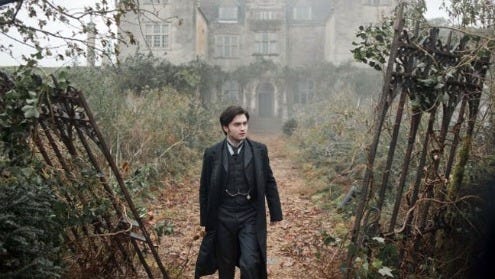Hammer Presents: The Woman in Black

The newly revived Hammer Film Productions releases a new addition to the Gothic horror genre this month. Is it worthy to stand alongside its other classics like “The Curse of Frankenstein” (1957)? Perhaps director James Watkins’ treatment of the novel by Susan Hill will bear testament to that. His previous horror/thriller, “Eden Lake” (2008), a terrifying and truly grim story about a couple being chased through the woods by a gang of youths, is a solid base from which to start.
In the 1980s, after American funding was withdrawn, Hammer stepped back from making films. In 2000, the company had a new lease on life when it was bought by a group of various bigwigs that included Charles Saatchi. Under new ownership, they co-produced a number of projects but weren’t fully back on the scene until “Let Me In” (2010) was released, a remake of the Swedish vampire thriller “Let the Right One In” (2008). Then, in 2011, came “Wake Wood,” the story of two parents who are given the opportunity to see their dead daughter again after she was savaged to death by a dog, and the weak stalker horror “The Resident.” “The Woman in Black” marks Hammer’s return to the beginning with a leap into Gothic horror.
In the last 10 years or so, British horror has been preoccupied with the zombie trend with Danny Boyle’s “28 Days Later ... ” (2002) and “28 Weeks Later” (2007) and Simon Pegg’s “Shaun of the Dead” (2004). Pegg’s contribution however is more on the side of black comedy than horror with his cast of well-known British comedians.
The other notable horror director on the scene is Watkins himself. “Eden Lake” boasts the well-known premise of a young couple being chased through the woods by crazies and now he’s back to the classics with the well-trodden reluctant protagonist fighting to survive in a haunted house. He has also contributed his writing skills to two other horrors as well, on “The Descent: Part 2” (2009) and “My Little Eye” (2002).
Radcliffe steps away from his Harry Potter character as troubled solicitor Arthur Kipps, a role which sees him as a young father and widower. To prove to his boss that he’s over his wife’s death, he travels to the Drablow house on Eel Marsh Estate (surely, going by those names, you would know what you were walking into) to settle the affairs of the late Mrs. Alice Drablow. The less-than-friendly locals in the village of Crythin Gifford warn him to stay clear of the house but he ventures across the marsh nonetheless.
The suspense in the film is done so well that even the trailer for “The Woman in Black” makes you shut your eyes a little. The setting for this bone-chilling adaptation is the ever-bleak Norfolk broads, a stretch of marshland that appears to go on forever. The land around the haunted house as grim and foggy as it should be, complete with depressed and frightened locals who offer warnings for young Kipps. His mission is reminiscent of Depp’s bumbling Constable Ichabod Crane and his adventure to Sleepy Hollow in Tim Burton’s “Sleepy Hollow” (1999) to solve the mystery of the Headless Horseman.
With this Victorian Gothic horror story and its simple premise, Hammer has made a careful step into making the films it was first known for. Its efforts in adapting European horror with “Let Me In” and now “The Woman in Black” herald a strong revival and a great anticipation for what’s to come.


